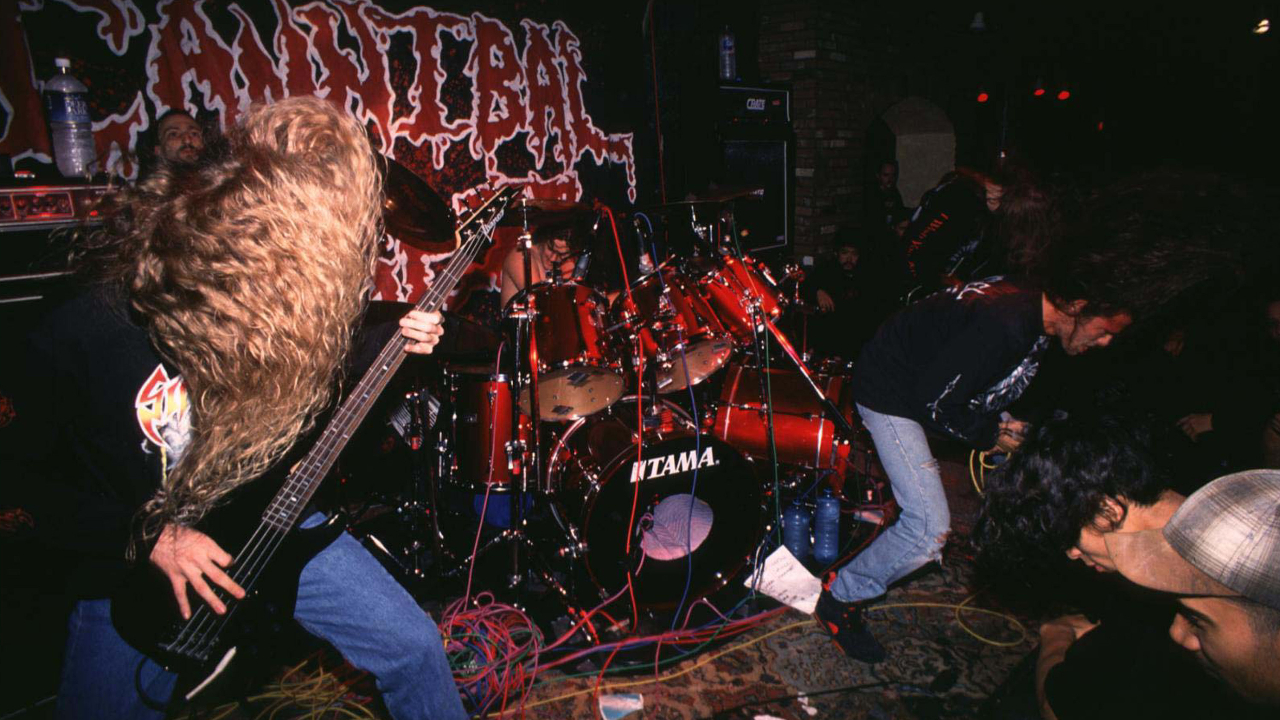“Hardcore innovators, soulful rockers and, frankly, the best band in the world you’re not listening to”: Every Thrice album ranked from worst to best
From scrappy debut Identity Crisis to refined latest album Horizons/East, we rank the back-catalogue of one of the most underrated bands on the planet right now

Thrice are a band who wear multiple hats. Since debuting at the dawn of the new millennium, the Californians have been post-hardcore innovators, soulful rockers and, quite frankly, the best band in the world that you’re not listening to. Their evolutionary career should be standard-bearing, yet for some reason they’ve never received the adulation they deserve.
It’s an injustice that we here at Metal Hammer are determined to rectify. From their riff-stacked debut Identity Crisis through to post-hiatus comeback To Be Everywhere Is To Be Nowhere and latest offering Horizons/East, we’ve revisited the four-piece’s impressive back-catalogue in the hopes of sorting it from worst to best. To be honest, though, pretty much all of it is bloody excellent.

11. Palms (2018)
Palms is far from a bad album (Thrice don’t know how to make such a thing), it just isn’t cohesive. Released following the streamlined rock of comeback To Be Everywhere Is To Be Nowhere, it shows the band trying to dabble in new ideas, but when compiled together, the acoustic math-rocker Blood On Blood, the piano ballad Everything Belongs and the pulsing synths of Only Us can’t form a congruent whole. Something this inspired being Thrice’s weakest moment says everything about their quality as a band, however.
10. Identity Crisis (2000)
Identity Crisis summarises 20 years of SoCal alt-music history in about 35 minutes. Equally smitten with hardcore, emo and metal, Thrice layer scream-singing vocals atop scurrying drums and the odd powerhouse riff. Their debut album is strewn with highlights, like the stampede of Metallica chugs during A Torch To End All Torches and Phoenix Ignition’s swing from folk whimsy to punk rock fury. The only knock against it is that the band got even better at sewing those influences on the albums afterwards.
9. Major/Minor (2011)
Had any other band released Major/Minor, it would probably be their masterpiece. It’s hard rock poetry, bolstered by singer/guitarist Dustin Kensrue’s earnest howls about abuse, religion and the follies of man. However, it was also the first Thrice album not to be a refinement or brazen leap away from what had come before. The band instead reused the same creative process they had for predecessor Beggars: jamming until they found affecting ideas. As a result, it can’t compete with the ambition of The Alchemy Index or the impact of Vheissu.
8. The Alchemy Index, Vols III & IV: Air & Earth (2008)
The Alchemy Index is whatever the opposite of a breakthrough is. It’s a two-CD, four-part piece where each quarter represents a different element – and major imprint Island Records were so perplexed by the masters that Thrice left. It’s the label’s loss: this second disc pairs ambient rock with piano-infused folk music to sublime results. There’s no hardcore to speak of, with A Song For Milly Michaelson and The Lion And The Wolf exposing the band’s tender heart. It only lands behind Vols I & II because of that pairing’s more dramatic diversity.
7. The Alchemy Index, Vols I & II: Fire & Water (2007)
While The Alchemy Index, Vols III & IV clash together two genres that are far from opposites, Vols I & II make a more dynamic double-whammy. The first half, Fire, blasts back to Thrice’s heavy music origins with its shouts and distortion. Then Water bubbles with evocative post-rock and trip-hop sounds. It’s a more immediate showcase of this band’s range than the two-parter’s 2008 counterpart. How many other artists could ever traverse the blazing Mastodon riffage of The Arsonist and Lost Continent’s crescendoing keyboards, yet alone on the same album?
Sign up below to get the latest from Metal Hammer, plus exclusive special offers, direct to your inbox!
6. The Illusion Of Safety (2002)
There’s a problem with stunning everyone with how eclectic you are: you can only do it once. Thankfully, The Illusion Of Safety isn’t the sound of Thrice throwing even more stuff into their sound. Rather than trying to outdo Identity Crisis, which got them a Hopeless Records deal and a Warped Tour slot, the band found focus amongst the variety. Deadbolt repeatedly returns to its tapalong guitars, Where Idols Once Stood savages with lightspeed drumming and A Subtle Dagger is an out-of-nowhere hardcore attack. Together, they became a deserved breakthrough moment.
5. Horizons/East (2021)
In five years, Thrice evolved from the dusty guitar anthems of To Be Everywhere… to Horizons/East: a bubbling bass and synth record. The Color Of The Sky instantly signals the shift, opening with wobbling keyboard noises, and Scavengers casts a revving-engine chorus riff against the isolated low end of its verses. Plus, Robot Soft Exorcism is the closest to trip-hop the band have ventured since The Alchemy Index. Add in the earworm hooks of Dandelion Wine and Summer Set Fire To The Rain and you get a late-in-the-game winner.
4. To Be Everywhere Is To Be Nowhere (2016)
Thrice’s comeback album is fucking heavy, man. Of course, that statement applies to the music: the band sourced influence from Cave In and Cult Of Luna to pen the hard crawl of Hurricane and the ear-splitting static of Whistleblower. But it’s also heavy thematically. To Be Everywhere… is a damning assessment of the modern world, as Black Honey savages the US’s foreign policy and Death From Above laments the pointlessness of drone strikes. Elegant and intense in equal measure, this made everyone thankful that Thrice’s absence was a short one.
3. Beggars (2009)
After The Alchemy Index forced them into four stringent moulds, Thrice broke free on Beggars, simply by jamming until they struck gold. The result is a driving rock record that crashes through mathcore, pop and prog. All The World Is Mad is an instant attention-grabber, containing one of the band’s career-best melodies. Wood And Wire is four minutes of solemn crooning over shuffling drums, then Talking Through Glass… is a post-hardcore explosion. The closing title track slows the pace – and it feels like a finale that’s twice as grand because of it.
2. The Artist In The Ambulance (2003)
Making their debut for major label Island Records, Thrice willingly put the blinders on, limiting their eclecticism to make all the money invested into them worthwhile. The band strengthened their songs in the process, with such mainstays as All That’s Left and Silhouette making a fusion of scream-along refrains, heavy metal riffing and punkish brevity seem easy. Suddenly, post-hardcore had new West Coast idols, to the point that Alternative Press said Kensrue and Teppei Teranishi were doing for punk’s guitar playing what Dave Murray and Adrian Smith from Iron Maiden had done for metal’s. Blimey.
1. Vheissu (2005)
The Artist In The Ambulance affirmed Thrice as a driving force of their scene – Vheissu declared that they were too talented to need a scene in the first place. The band have since called their fourth album “a reaction to Artist…”, huddling prog, ambient, acoustic and keyboard sounds under a blanket of hook-laden rock.
Image Of The Invisible into Between The End And Where We Lie is the best one-two punch in Thrice’s history, segueing from gang-chanted choruses to a polyrhythmic drums-and-piano riff. Hold Fast Hope is a thousand-watt spotlight on Kensrue’s vocal prowess, Like Moths To Flame dances from classical to metal and folk and back again, and Red Sky is a delicate post-rock conclusion.
Together, these songs realised Thrice’s full potential, and they thrust the band to number 15 on the American charts. It was their most relevant moment – not to mention a perfectly-timed leap into timelessness as post-hardcore began its downswing.

Louder’s resident Gojira obsessive was still at uni when he joined the team in 2017. Since then, Matt’s become a regular in Metal Hammer and Prog, at his happiest when interviewing the most forward-thinking artists heavy music can muster. He’s got bylines in The Guardian, The Telegraph, The Independent, NME and many others, too. When he’s not writing, you’ll probably find him skydiving, scuba diving or coasteering.
You must confirm your public display name before commenting
Please logout and then login again, you will then be prompted to enter your display name.
![Thrice - Anthology [Audio] - YouTube](https://img.youtube.com/vi/YoItyo561co/maxresdefault.jpg)
![Thrice - Black Honey [Official Video] - YouTube](https://img.youtube.com/vi/C9GTEsNf_GU/maxresdefault.jpg)

